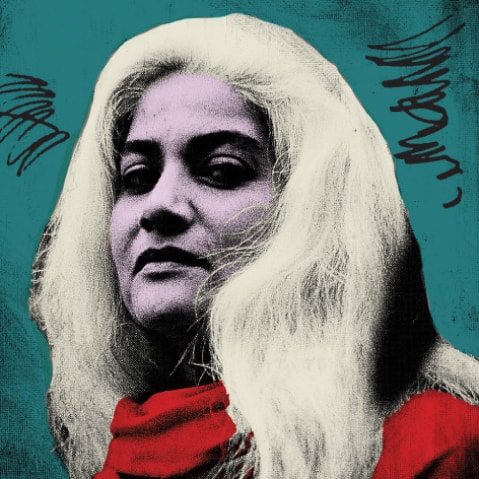
As the election draws near, the battle of the image has acquired a frantic momentum. Posters are put up in any available space, and then taken down — smiling, turbaned, clean-shaven, moustached, bearded or draped in dupattas and the inevitable lewd images — shared on social media. Videos are shared, and a whole industry emerges for songwriters, performers, printers, production houses and poster pastors.
Ballot paper symbols arrive looking like a child’s qaida or first alphabet reader — some familiar, such as the lion, kite and cricket bat; some incomprehensible and inevitably comical, like the ones shared by blogger Rameeza Ahmad: an energy saver bulb, a laptop, an air conditioner, an ostrich and an eggplant (who would accept a symbol that evokes the phrase “thali ka baingan!)”
Statecraft has always depended greatly on images. The Pharoahs commissioned monumental statues as did the Mesopotamian empires, the Greeks and Romans and continuing right into the 20th century. Coinage carried the image of the ruler far and wide. It is difficult to imagine that 21st-century states would consider commissioning statues of their rulers, and even coins are rarely minted with an image of a country’s ruler. Saddam Hussein’s statue was probably the last of its kind. This is at least in part due to widespread access to the internet and digital imagery. Images can no longer be controlled and disseminated by those in power. Great leaders, public figures, movie stars, become ordinary like us when we can download or photoshop them on our laptops.
Arjumand Hussain lost his job as general manager of Gerry’s for sharing a cell phone video of lawmaker Rahman Malik being refused to board a PIA plane by passengers annoyed at being delayed to accommodate his late arrival. But Hussain became a hero overnight. The police in America are regularly challenged by publicly-shared cell phone footage of excesses.
More than 90 percent of all the information that comes to the brain is visual. We recognise and understand a scene in less than one-tenth of a second.
At a time when to caricature royalty or politicians was punishable by death, nursery rhymes were composed disguising political commentary: Baa Baa Black Sheep against a 13-cents tax on wool by King Edward I, Rock a Bye Baby referred to the smuggling of a male child into the birthing room of the queen to ensure James II had an heir, Mary, Mary Quite Contrary refers to the torture of Protestants by Mary Queen of Scots. Goosey Goosey Gander was about religious persecution when Catholics were forbidden to say Latin prayers even in their homes. The list goes on. Today, the laws have become more liberal and cartoonists and photographers can reach audiences bypassing the editorial control of a newspaper editor.
In their book, The Mouse that Roared: Disney and the End of Innocence Henry A. Giroux and Grace Pollock reveal that Disney created the concept of EPCOT — “Experimental Prototype Community of Tomorrow” — giving the power to manage society and its values to corporations that will, in time, banish the need for politics altogether. His white, middle-class, suburban values, disseminated through Mickey Mouse and his cartoon colleagues and a string of Disney films, is a global phenomenon as nearly 13 billion hours have been spent in contact with Disney brands.
More than 90 percent of all the information that comes to the brain is visual. We recognise and understand a scene in less than one tenth of a second. However, visual perception also involves interpretation, analysis and awareness.
Lina Khatib in her book Image Politics in the Middle East: The Role of the Visual in Political Struggle explains, “Politics in the Middle East is now seen” via mass media, digital imagery, posters, messages on wall, or cartoons. Images of the Twin Towers, Abu Ghraib, Saddam’s execution video and Banksy’s graffiti on the Palestinian/Israel wall are enduring and politically influential images. Hypermedia — email, Facebook, mobiles, YouTube, and now Twitter, Instagram and Snapchat — is a serious challenge to the power of governments and regulatory bodies.
Picasso’s ‘Guernica’ and Goya’s war paintings were seen by a few. During the first Gulf War it was possible to impose a ban on live media coverage. Today, an overwhelming number of images and videos from the Middle East battlefronts or any corner of the world is accessible to everyone.
Inevitably, as with all new technology, it is equally used for malicious manipulation. Private lives are distastefully exposed. The spread of false images — known today as “fake news” — by individuals or government institutions is a new version of yellow journalism, a term ironically associated with Joseph Pulitzer of Pulitzer Prize fame. Subliminal messaging dating back to the 1950s and visual cryptology — the creation of two Israelis, Moni Naor and Adi Shamir — are even darker uses of imaging.
Acquiring visual authorship creates opportunities for performers such as Justin Bieber, who became visible through his songs uploaded by him on YouTube, or by chance images that go viral, such as Arshad Khan aka “Chaiwala,” who went on to become a model, the politician Sheikh Rashid, dodging detection to arrive at a public meeting on a motor bike, the outspoken old lady with her “bik gai hai gorement” rant or, tragically, Qandeel Baloch, who made one video too many.
Durriya Kazi is a Karachi-based artist and heads the department of visual studies at the University of Karachi
Email: durriyakazi1918@gmail.com
Published in Dawn, EOS, July 15th, 2018
















































